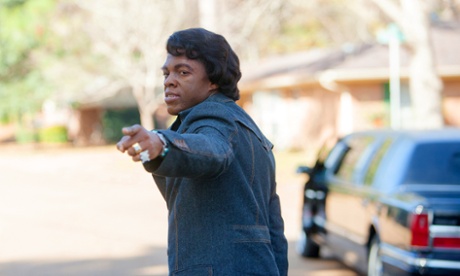
“There ain’t nothing to cry about,” James Brown comforts his mother toward the end of Tate Taylor’s new biopic of the singer, Get On Up. “I’m James Brown.” The line is a superb distillation of the narcissistic compact between all great entertainers and their audiences: what possible reason for sorrow could there be in a world in which I exist?
It could also be read as a rebuke to the dreary rags-to-riches plod of the biopic, in which the only smiles are those through tears, no portent of future greatness left undelivered, no demon unconfronted. By way of contrast, Get On Up kicks off with two scenes that would, I think, feature fairly low down anyone’s list of expected scenes in a biopic of a Major Entertainment Figure. In the first, James Brown (Chadwick Boseman), high as kite on PCP, holds an insurance seminar at gunpoint because one of its attendees used his private bathroom. “Who used my kermode?” he barks before accidentally firing his shotgun into the ceiling. Cut back a decade, and Brown is now onboard a USO plane, dodging tracer fire from jungles of Vietnam, bending the ear of the pilot as they descend. “They tried to kill James Brown,” he says afterwards, insulted, as if by the effrontery. The Ego has landed.
With a time scheme closely modelled on an ice hockey puck and a central performance closely modelled on the more colorful breed of rooster, Get On Up is that rare biopic that leavens its respect with a little light mockery. It befits a subject who meets the final turn of Fate’s Wheel dressed in a lime green jumpsuit and hair-rollers. The film hardly skimps on the cliches of the genre: we get the hardscrabble youth, with Brown abandoned by both parents to fend for himself in his aunt’s brothel. We get a walk-on part for Little Richard (Brandon Smith), flipping burgers in a hairnet and warning of Satan’s dollar. And finally we get Brown’s big break, arriving via music manager Ben Bart (Dan Ackroyd) who comes bearing a white Cadillac as a gift. Brown is unimpressed, and proceeds to outline his touring strategy – a street-level meet-n-greet of local DJs and record store owners to catch the “late-night cats” – all delivered to camera, while Ackroyd sits there yakking on, one of many such shimmies over and under the fourth wall. It could almost be a Spike Lee joint. Who knew the director of The Help had this level of stylistic playfulness in him?
The soliloquy not only underlines Brown’s marketing savvy, it also lays out the basic topography of the cast, which divides up neatly into two groups: those lucky enough to be James Brown, and the rest of us. The former are more numerous than you’d think, thanks to the singer’s cunning rotation of personas, which the film uses to keep track of the time’s onward march – Mr Dynamite, the Hardest Working Man in Show Business, Soul Brother No1, the Godfather of Soul, the Original Disco Man, each with its own costume change: a sapphire blue soot suit, a fur coat and cowboy hat, a Gold-lamé leotard split to the navel, for those intimate tête-à-tête moments with 10,000 screaming fans. The songs have been remastered – Cold Sweat, in particular, packs such a mule kick it feels like a test to see if you can physically remain in your seat – although the best is yet to come, as Brown halts the song to ask each band member what instrument they are playing – “The guitar? No you’re playing the drums.” “A horn? No, drums.” All the members of his band are part of the rhythm section. And all do his bidding.
Boseman comes to the role from Brian Helgeland’s 42, in which he played Jackie Robinson as the very model of patient humility. Here, he lets rip. Chest puffed out like a cockerel, coiffed hair on a vertical ascent “to the lord”, he has Brown down: the pigeon-toed to the mike, hands dandyishly splayed, face contorted as if burning up in his own heat, propelled across the stage by the sheer voltage force of being James Brown. It’s one of the year’s truly outstanding performances, even if the movie never quite penetrates Brown’s rhino-rough hide. His selfishness sucks up all the available air. We get a show in Boston following the assassination of Dr King, in which Brown quells a riot, but his rage at the possibility of his show being cancelled is the more vivid moment; likewise a scene with school children in which he preaches the Gospel according to St James –“You can be anybody you like” – feels like just more megastar glow-basking (You, too, can be me). By the time the film is done, Get On Up seems less like an invitation to dance, still less have sex, and more like straightforward career advice. “Watch me!” he intones, “Watch me!”, and we couldn’t do anything but.
Taylor realises his film lacks an emotional core, and he cuts back for a scene in which Brown tearfully turns away his mother (Viola Davis) from his dressing room; then in order to explain his cold heartedness, he footnotes that flashback with another, to show her earlier renunciation of him – a very model of telescoping redundancy. Moreover, the emotion feels fake: Brown was a brute with women, and is a weak candidate for an attack of biopic fuzzy-wuzzies. Much more accurate is the scene in which Brown sings an a cappella version of I Need You to Bobby Byrd, his long-suffering lieutenant: a lovely portrait in soft-spoken forbearance from Nelsan Ellis. Byrd sits in the audience, his beard now greying, eyes brimming with tears, unable as he ever was to take his eyes off the boss. It’s a Man’s World, indeed.
Get On Up is in US theatres on 1 August and UK threatres on 26 September

